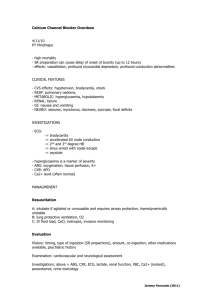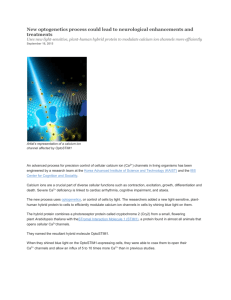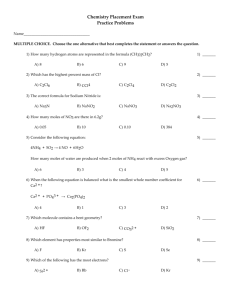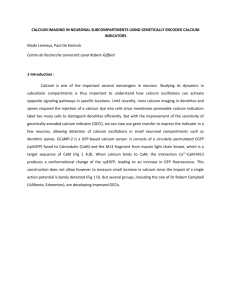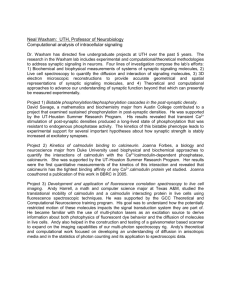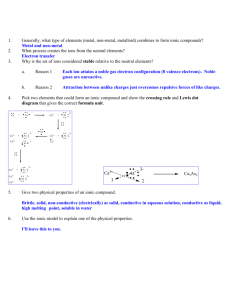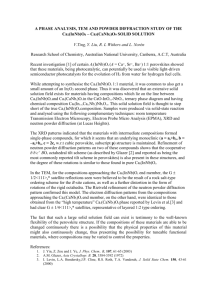Calcium Model
advertisement
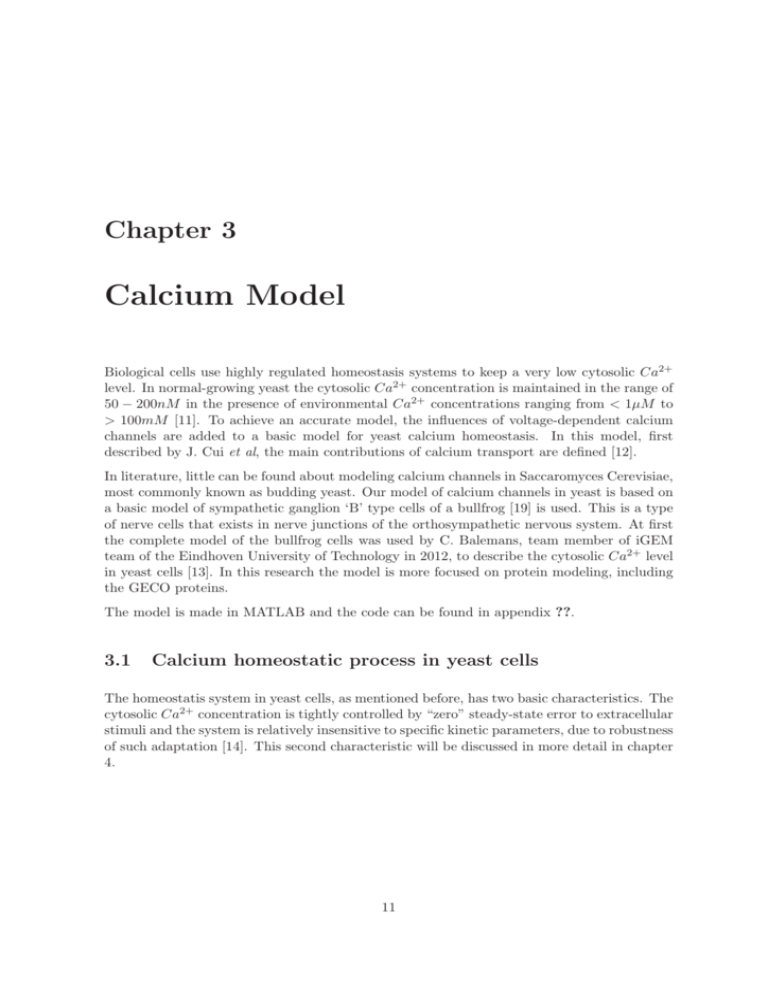
Chapter 3
Calcium Model
Biological cells use highly regulated homeostasis systems to keep a very low cytosolic Ca2+
level. In normal-growing yeast the cytosolic Ca2+ concentration is maintained in the range of
50 − 200nM in the presence of environmental Ca2+ concentrations ranging from < 1µM to
> 100mM [11]. To achieve an accurate model, the influences of voltage-dependent calcium
channels are added to a basic model for yeast calcium homeostasis. In this model, first
described by J. Cui et al, the main contributions of calcium transport are defined [12].
In literature, little can be found about modeling calcium channels in Saccaromyces Cerevisiae,
most commonly known as budding yeast. Our model of calcium channels in yeast is based on
a basic model of sympathetic ganglion ‘B’ type cells of a bullfrog [19] is used. This is a type
of nerve cells that exists in nerve junctions of the orthosympathetic nervous system. At first
the complete model of the bullfrog cells was used by C. Balemans, team member of iGEM
team of the Eindhoven University of Technology in 2012, to describe the cytosolic Ca2+ level
in yeast cells [13]. In this research the model is more focused on protein modeling, including
the GECO proteins.
The model is made in MATLAB and the code can be found in appendix ??.
3.1
Calcium homeostatic process in yeast cells
The homeostatis system in yeast cells, as mentioned before, has two basic characteristics. The
cytosolic Ca2+ concentration is tightly controlled by “zero” steady-state error to extracellular
stimuli and the system is relatively insensitive to specific kinetic parameters, due to robustness
of such adaptation [14]. This second characteristic will be discussed in more detail in chapter
4.
11
CHAPTER 3. CALCIUM MODEL
Figure 3.1: A schematic graph illustrating the protein level observations of the yeast calcium homeostasis system. Channel Cch1-Mid1 on the plasma membrane opens only under abnormal conditions.
The vacuole can release Ca2+ into the cytosol through Yvc1, though only under the abnormal conditions of an extracellular hypertonic shock [12].
Under normal conditions, extracellular Ca2+ enters the cytosol through an unknown Transporter X, whose encoded gene has not been identified yet. Cytosolic Ca2+ can be pumped
into endoplasmic reticulum (ER) and Golgi system through Pmr1 and can be sequestered into
the vacuole through Pmc1 and Vcx1. Both the expression and function of Pmc1, Pmr1 and
Vcx1 are regulated by calcineurin, a highly conserved protein phosphatase that is activated
by Ca2+ -bound calmodulin [12].
Figure 3.2: Block diagram of calcium homeostasis under normal conditions. Through unknown
Transporter X, extracellular Ca2+ , denoted by [Caex ], enters the cell. Proteins Pmr1, Pmc1 and Vcx1
cause feedback control through calmodulin and calcineurin. Crz1 is a transciptional factor and ‘?’
denotes an unknown mechanism [12].
12
CHAPTER 3. CALCIUM MODEL
3.2
Feedback modeling
3.2.1
Sensing cytosolic Ca2+
Calmodulin is a Ca2+ -binding protein expressed in all eukaryotic cells. The protein binds
to cytosolic Ca2+ as a response to an increase of the Ca2+ level in the cell. A host domain
for target proteins, including calcineurin, is activated. In yeast cells, calmodulin can only
bind to a maximum of three molecules of Ca2+ [15]. A strong cooperativity among the three
active sites can be assumed. Therefore the cytosolic Ca2+ sensing process can be described
as follows:
3Ca2+ + Calmodulin *
(3.1)
) CaM
where CaM denotes Ca2+ -bound calmodulin. The concentration of Ca2+ -bound calmodulin
will be denoted as CaM(t) and can be described by mass-action kinetics with forward rate
+
−
constant kM
and backward rate constant kM
as follows:
dCaM (t)
+
−
= kM
([CaMtotal ] − CaM (t)) · Ca(t)3 − kM
CaM (t)
dt
(3.2)
where [CaMtotal ] denotes the total concentration of calmodulin, the sum of Ca2+ -free and
Ca2+ -bound calmodulin.
3.2.2
Calcineurin activation
Upon elevation of cytosolic Ca2+ , Ca2+ -bound calmodulin binds to the catalytic subunit
of calcineurin and activates calcineurin by displacing the carboxyl-terminal autoinhibitory
domain. This binding process can be described as:
CaM + Calcineurin *
) CaN
(3.3)
where CaN denotes activated calcineurin. The concentration of Ca2+ -bound calneurin will be
+
denoted as CaN(t) and can be described by mass-action kinetics with forward rate constant kN
−
and backward rate constant kN . Since each molecule of calcineurin binds with one molecule
of Ca2+ -bound calmodulin, we can derive the following equation:
dCaN (t)
+
−
= kN
([CaNtotal ] − CaN (t)) · CaM (t) − kM
CaN (t)
dt
(3.4)
where [CaNtotal ] denotes the total concentration of calcineurin, the sum of Ca2+ -free and
Ca2+ -bound calcineurin.
3.2.3
Gene expression control
Experimental results show that activated calcineurin regulates the production of the proteins
Pmc1 and Pmr1 by controlling the synthesis of these two proteins through a transcription
13
CHAPTER 3. CALCIUM MODEL
factor Crz1 [16]. Crz1 is a highly phosphorylated protein that can be dephosporylated by activated calcineurin. We assume that only fully dephosphorylated Crz1 molecules in the nucleus
are transcriptionally active since this has been shown the case for NFAT1. The mechanism
of Crz1 translocation in yeast cells is similar to NFAT (nuclear factor of activated T-cells)
translocation in mammalian T-cells. Therefore, some of the parameters stated in this chapter
are based on experimental data on NFAT1. A conformational switch model is used to simulate
Crz1 translocation, as described by Okamura et al [17]. By describing the conformational
switch model as a protein network and using the rapid equilibrium approximation [18], we
can use the following equation to describe the kinetics of the total nuclear Crz1 fraction which
is denoted by Crz(t):
dCrz(t)
= d · φ(1/CaN (t)) · (1 − Crz(t)) − f · (1 − φ(1/CaN (t))) · Crz(t)
dt
(3.5)
d denotes the import rate constant, f denotes the export rate constant and φ denotes the
ratio of the fraction of the cytosolic active conformation over the total cytosolic fraction:
φ(y) = 1/(1 + L0 ·
(λy)N +1 − 1
y−1
·
)
λy − 1
(y)N +1 − 1
(3.6)
where N is the number of relevant regulatory phosporylation sites, experimental data shows
that N = 13 in the case of NFAT1. L0 denotes the basic equilibrium constant and λ is the
increment factor. The conformational switch model and deduction of the function dCrz(t)
is
dt
described in more detail in appendix C.
As mentioned before, Crz1 is a transcription factor which controls the synthesis of Pmc1
and Pmr1. The concentrations of these two proteins are assumed to be proportional to
transcriptionally active Crz1 fraction in the nucleus and therefore:
[P mc1] = ka · h(t) · θ(1/z(t))
(3.7)
[P mc1] = kb · h(t) · θ(1/z(t))
(3.8)
where [P mc1] and [P mr1] denote the concentrations Pmc1 and Pmr1 respectively and ka , kb
denote the feedback control constants.
For the feedback regulation of activated calcineurin on the synthesis of Vcx1, the process is
stil unknown. The only knowledge about this regulation is that the mechanism is possibly
posttranslational and the general effect is suppressing. As an approximation this regulation
is expressed as follows [12]:
[V cx1] = kd /(1 + kc · CaN (t))
(3.9)
where kc and kd denote the feedback control constants. As stated by this equation, the
concentration of Vcx1 will drop when CaN(t) rises.
14
CHAPTER 3. CALCIUM MODEL
3.3
Protein modeling
All four involved proteins (Transporter X, Pmc1, Pmr1 and Vcx1) can be described by the
Michaelis-Menten kinetics, often used to describe simple enzymatic reactions. For example,
the uptake rate of Transporter X, k, can be described by:
k=
Vmax · [Caex ]
Kx + [Caex ]
(3.10)
where Vmax (µM s−1 ) is the maximum uptake rate of Transporter X and Kx (µM ) is the binding
constant.
3.3.1
GECO proteins
The iGEM team of the Eindhoven University of Technology in 2012 uses the fluorescent
activity of CMV-X-GECO.1 proteins as light-emitting part of the cell, as a result of an
increase of the cytosolic Ca2+ -level. Therefore, also the kinetics of calcium binding by these
G-GECO proteins need to be taken into account. Although three different GECO proteins are
used (CMV-R-GECO1, CMV-G-GECO1.1 and CMV-B-GECO1) to provide different colors,
only the variant CMV-G-GECO1.1 is discussed. The kinectic characterization of the different
GECOs can be found in table 3.1. Upon elevation of cytosolic Ca2+ -level, Ca2+ binds to the
GECO protein, a process that we can described as follow:
nCa2+ + GECO *
) CaGECO
(3.11)
where CaGECO denotes Ca2+ -bound GECO protein and n the number of Ca2+ molecules
that binds to the protein. This equation yields a forward rate constant kon and a backward
rate constant kof f as mentioned in table 3.1.
Protein
R-GECO1
G-GECO1.1
B-GECO1
kon (M −n s−1 )
9.52 ·109
8.17 ·1015
4.68 ·1012
kof f (s− 1)
0.752
0.675
0.490
n
1.6
2.6
2.0
Kd,kinetic (nM )
484
809
324
Kd,static (nM )
482
618
164
Table 3.1: Kinetic characterization of GECO proteins [10].
We can assume [GECOtotal ], the total concentration of GECO (including Ca2+ -bound and
Ca2+ -free form) to be constant. If we further denote the concentration of Ca2+ -bound GECO
protein as CaGECO(t), then according to the law of mass action, we can derive the time
dependence of CaGECO(t) as follows:
CaGECO0 (t) = kon ([GECOtotal ] − CaGECO(t)) · Ca(t)n − kof f CaGECO(t)
15
(3.12)
CHAPTER 3. CALCIUM MODEL
3.4
Ionic Current Flow
The largest flux of calcium ions into the cell occurs via voltage-dependent channels. Equation
3.13 [19] shows the change in calcium concentration in the cell on account of the influx, with
[Ca2+ ] the intracellular calcium concentration (mM ), ICa2+ the calcium current (nA) and
Vn the volume of the cell (l). Faraday’s constant, F , converts the quantity of moles to the
quantity of charge for a univalent ion [20].
−ICa2+
∂[Ca2+ ]
=
∂t
2F Vn
(3.13)
Generally, ionic currents can be described by Ohm’s law [19]:
I(t) = g(t, V ) · (V − E)
(3.14)
In this equation, g is the time and voltage dependent conductance (µS), V is the voltage
(mV ) and E is the Nernst potential (mV ). The conductance associated with the channel can
be calculated by equation 3.15 [19], with ḡ the maximum conductance of the membrane, m
the activation variable (−), h the inactivation variable (−) and i and j positive integers.
g(t, V ) = ḡ · m(t, V )i · h(t, V )j
(3.15)
The dynamics of the activation variable can be found using equation 3.16 [19], where m∞ is
the steady state value of m and τm is a characteristic time constant (s).
dm(t, V )
m∞ (V ) − m(t, V )
=
dt
τm (V )
(3.16)
The steady state value of m, m∞ , and the time constant, τm , can be described using the
Hodgkin-Huxley equations. Equations 3.17 [19] and 3.18 [19] are the Hodgkin-Huxley equation, suited for the calcium influx.
τm =
e+(V +6)/16
m∞ =
7.8
+ e−(V +6)/16
1
1+
e−(V −3)/8
(3.17)
(3.18)
The dynamics of the inactivation variable is given by equation 3.19 [19], a simple MichaelisMenten equation, with K an equilibrium constant related to the concentration at which
inactivation is halfway (µM ).
K
(3.19)
hCa2+ =
K + [Ca2+ ]
Equation 3.20 [19] is the Nernst equation for calcium.
ECa2+ = 12.5log
[Ca2+ ]ex
[Ca2+ ]
In this equation, [Ca2+ ]ex is the constant extracellular calcium concentration (µM ).
16
(3.20)
CHAPTER 3. CALCIUM MODEL
3.5
Cytosolic calcium level
As a result of the uptake models for all the involved proteins, including the GECO proteins,
models for the relevant feedback regulation and models for the calcium channels, the main
equation for the concentration of cytosolic calcium can be derived:
dCa(t)
dt
=
1
Vx · [Caex ]
V1 · Ca(t)
− Crz(t)θ(
)
Kx + [Caex ]
CaN (t) K1 + Ca(t)
|
{z
} |
{z
}
T ransporterX
P mc1
1
V3 · Ca(t)
V2 · Ca(t)
1
− Crz(t)θ(
)
−
CaN (t) K2 + Ca(t) 1 + kc CaN (t) K3 + Ca(t)
|
{z
} |
{z
}
P mr1
V cx1
− n(kon · CaGECO(t) − kof f · Ca(t)n ([CaGECOtotal ] − CaGECO(t)))
{z
}
|
GECO
− αCa(t)
(3.21)
The final model consists of six equations (Eqs. 3.4, 3.2, 3.12, 3.5, 3.21, 3.16) and six unknowns:
CaN (t), CaM (t), CaGECO(t), Crz(t), Ca(t) and m(t).
3.6
Calcium Diffusion
After entering the cell, the calcium will be transported through the cell by diffusion. Since the
cell is sphere-like, the diffusion equation will be formulated in spherical coordinates. When
the tangential components are neglected, the three-dimensional equation is reduced to a onedimensional problem, which can be found in equation 3.22 [19].
∂r[Ca2+ ]
∂ 2 r[Ca2+ ]
=D
∂t
∂r2
(3.22)
In this equation, D is the diffusion constant (µm2 s−1 ) and r is the radius of the cell (µm).
Because of the dependence on both space and time and the complexity to model this, the
calcium diffusion in the cell is neglected in our first attempt to model calcium dynamics in
the cell. However, in order to reliably predict calcium dynamics in the cell, future studies
should address the role of diffusion.
17
